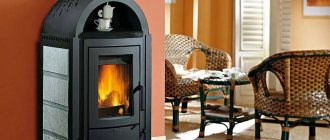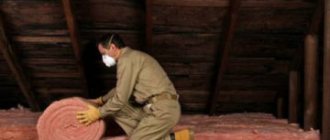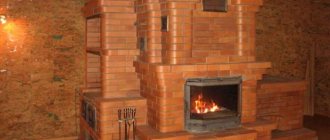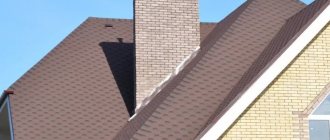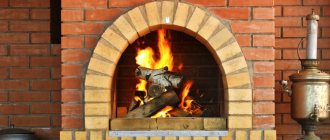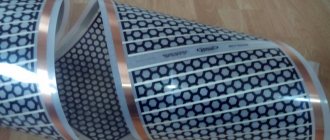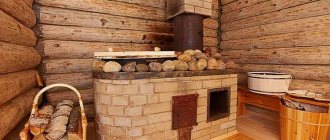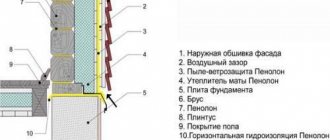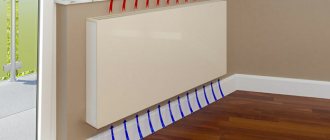One of the signs of the convenience of living in a private cottage is its consistently comfortable environment at any time of the year. No matter how beautiful the structure, only a warm house can be truly cozy. One of the best solutions is to organize heating using a brick stove for the home. The advantages of this material are obvious - the variety of shapes allows brick stoves to harmonize with any environment, and the heat transfer characteristics are among the best.
With proper design and installation, a brick oven can also be used in wooden houses Source taldomstroi.ru
What types of brick stoves are there for houses?
Brick stoves intended for residential buildings are divided into the following types:
- Heating. The main purpose is to provide heating for individual rooms or the entire house;
- Cooking. The design is designed in such a way that the main heat flow goes upward - to the hob. Such a stove is heated only during cooking;
- Heating and cooking. Essentially, it is a heating stove with a hob. Since such a stove has a mixed functional purpose, cooking food on it in the summer is not always comfortable.
Whatever type of stove it is, some general qualities must be present in any case:
- the oven should warm up well;
- the chimney design must provide good draft;
- high level of general fire safety;
- the stove should fit harmoniously into the overall environment, creating a feeling of comfort.
Based on the shape of the product, brick kilns are divided into square, round, corner, T-shaped, and rectangular.
Heat transfer is primarily affected by the thickness of the walls of the product. Based on this parameter, furnaces are made of thick-walled, thin-walled and combined types.
The thickness of the walls is determined not only by the number of bricks, but also by the method of laying them Source akson-quick.ru
It is better to heat the stove with wet rather than damp wood...
Yes, that's true, but it's a joke. It is better, of course, to heat the stove with dry wood. Let's take a closer look at what dry, wet, wet and damp firewood is...
Wet firewood
Freshly cut firewood is considered damp. The relative humidity of such firewood is 50-100%. In such firewood, not only the intercellular space is filled with moisture. The pores through which moisture is delivered to the foliage - “channels”, “tracheids”, whatever you want to call them) - are also filled with moisture.
Damp firewood will not give the required temperature, if at all it burns and does not smolder. The fact is that for rapid evaporation of moisture in firewood, a significant temperature is needed. If you put a raw log in a hot firebox, it may even increase the intensity of the chemical processes of oxidation - combustion. After all, water begins to burn at high temperatures. But this is a topic for a separate article.
So, damp firewood will not provide the required temperature for ignition - there will be problems with melting it. Even if you melt such an armful, the moisture from the firewood will not go anywhere, but will fill the stove channels and can form an air lock. A combination of factors - low temperature of burning gases (in wet wood) and air humidity in the stove - will cause problems with draft.
Wet firewood
We accept firewood dried outside as conditionally dry, its relative humidity is 20-30%. But such firewood is quite hygroscopic. They can both quickly gain moisture and quickly release it.
Firewood with a relative humidity of 30% or more can be called wet, although it may appear dry. The fact is that moisture in the tracheid canals of wood evaporates faster than intracellular moisture. Therefore, firewood with a moisture content of up to 30% is conditionally dry firewood. This is the moisture content of firewood that is normal for outdoor drying.
Firewood that has been exposed to rain or soaked in anything is wet firewood. But this does not mean that they are raw. Firewood exposed to rain, if it was not damp, is still better than raw firewood, even if it appears dry. Well, something like this…
Now about dry firewood.
Advantages and disadvantages of a brick stove in the house
There are several reasons why a brick stove for a home is more preferable than products made from other materials:
- The design, thought out to the smallest detail, perfectly serves as a heat storage device. It is this feature that allows you to fire a brick stove much less often than other analogues (steel, cast iron). The heat retention period is about 24 hours. For comparison, firewood should be added to metal stoves every 5-6 hours;
- Due to the high accumulation of heat, a brick oven is highly economical and less harmful to the environment, which cannot be said about its metal counterparts. Optimal combustion of fuel gives maximum heat transfer; almost complete decomposition of organic matter is observed - splitting into carbon dioxide and a water base. Excess heat heats the masonry, which in turn warms the rooms;
- There is no effect of incandescence on the outer parts, so the thermal radiation of brick structures is much softer than that of steel ones.
On the outside, the bricks are hot, but not red-hot, unlike iron parts Source minsknews.by
This is interesting! When heated, the moisture condensed in the pores evaporates from the bricks, and when cooled, it is absorbed back. This process is commonly called stove breathing and thanks to it, the humidity level of the heated air always remains comfortable - from 40 to 60%. Other heating devices require the installation of an additional humidifier; without it, the air dries out.
Also, a stove in a brick house is not without its disadvantages:
- The long cooling of the brickwork, scientifically called thermal inertia, is a big plus, but this coin also has a downside - an equally long warm-up. Therefore, when lighting a stove in a cold room of a large area, the temperature in the house will rise slowly - this is especially felt in the far corners. In this case, it is additionally recommended to purchase a convector.
- Since a brick oven is a fairly massive structure, ideally it is erected simultaneously with the house. The furnace must function without interruption, so special knowledge and experience are needed to design and build it. Even despite free access to drawings with orders for brick stoves for the home, you can’t do this without a specialist, and good stove craftsmen are in short supply.
For high-quality laying of stoves, it is not enough just to know the order - this work has many nuances, knowledge of which comes only with experience Source fasaddomstroy.ru
See also: Catalog of companies that specialize in the installation of fireplaces and stoves
Features of the design and functioning of Russian stoves
The construction of the furnace is carried out using brickwork. Its design is a rather complex engineering structure with a whole labyrinth of passages (wells) through which flue gases slowly pass, transferring heat through the wall to the internal air of the house. Adjustment of the heat supply, exhaust gas outlet and traction force is carried out by two special dampers; you need to know their functions in order to understand how to properly heat a Russian stove with wood.
Russian stove in the interior of the house
Design device:
- An under-stove, a recess made in the area of the base of the stove. Despite the fact that today many craftsmen do not install it in order to save on construction work, experts still recommend installation, since this element has the important function of storing and drying firewood.
- A stove is a niche, preferable for storing dishes; there is no temperature heating in it.
- A shelf is a horizontal plane in front of the furnace, onto which dishes are placed from the hearth so that the food remains hot. In modern stove designs, a cast iron hob is installed in this place.
- Under (bottom) - a base in the hearth located with a slight slope in order to easily move heavy cast-iron cookware.
- The crucible is the main internal space of the stove, which simultaneously performs the functions of the combustion and cooking chambers and has a slope towards the exit. This design retains hot gases under the roof, so they have time to heat the stone mass of the furnace walls.
- The bend is a transition zone between the horizontal surfaces of the stove with different temperature conditions.
- The peretrube or hailo is a gas collector located above the pole, followed by a chimney.
- A samovar (dushnik) is a narrow chimney going into the main gas outlet, to which a samovar pipe was previously connected. The device is currently not being implemented.
- View - a hatch in a vertical chimney above the hearth, blocking it completely if necessary and when the stove is not heated. Through it there is access to the valve that regulates the draft in the device. Bed.
Design of a Russian stove
Operating principle of the stove:
- In the combustion chamber, which acts as a modern recuperator, the incoming air is heated by combustion products. The mixing process is not carried out due to different densities of the media. Calculations carried out by experts have proven zero turbulence at the interface between both flows - hot and cold. The surfaces of the heat and bend are made smooth, and therefore oxygen supplied to the furnace from the air ensures complete combustion of the fuel.
- The heated combustion products rise to the roof of the furnace. The slope and small threshold prevent the free movement of smoke to the high, creating stable circulation zones. This is where the power of the Russian stove lies. Therefore, it is necessary to accurately carry out all the main dimensions during construction.
- Circulation zones retain unburnt fuel particles in the high-temperature flame area for a long time, thereby increasing the completeness of firewood combustion. The heated vault and walls become a source of infrared heat exchange, uniformly heating the food in the crucible.
- The folding acts as a thermal economizer, which allows food to remain hot throughout the day. To do this, the chimney is closed (when the fuel is completely burned), and the mouth is closed with a wooden damper.
- The smoke circulation of the stove occurs with a minimal temperature gradient. The constant temperature of the flue gases with strong circulation in the combustion zone ensures that even the smallest particles are burned in the furnace. This process does not form soot and soot in the flue ducts; they are deposited on the walls of the furnace, so it must be cleaned only a few times during the entire period of operation.
The principle of operation of the Russian stove
Which brick to choose for the stove
When choosing a brick, attention is primarily focused on its resistance to temperature influences. The building material must withstand repeated heating and cooling procedures. The overall service life of the stove depends on the characteristics of the brick from which the stove will be made.
It is customary to mark bricks. One of the main indicators is density and strength grade. The denser the product, the slower the kindling and heating will occur. To build a stove, you need bricks whose markings indicate strength grade M150-250, with maximum thermal conductivity and minimum hygroscopicity.
Note! Density itself is not a sign of quality. A strength grade that is too high may indicate the presence of substances in the brick that are harmful to humans when heated.
The next marking indicator is the level of frost resistance, which should be the highest. It plays an important role when choosing products used in laying the chimney (especially the part protruding above the roof).
Marking of bricks for stoves in comparison with other types of material Source iqlevsha.ru
Frost resistance implies the ability of a product to absorb moisture. Its crystallization inside the material can cause deformation of the latter. Hollow facing ones are better suited.
When forming the inside of the chimney, you need solid red brick. Plastic molding is preferred. These products withstand temperature changes and do not crack even with significant downtime.
Use in the construction of furnaces is contraindicated:
- silicate and pressed bricks;
- bricks made using the slip casting method;
- unfired raw materials.
The maximum aging of fireclay bricks (made in accordance with GOST) is up to 1350 °C. It is quite possible to use such products to create most of the structure or to use them separately for thermal protection (lining) of internal surfaces.
The Sh8 brand is suitable for the firebox (such bricks have a straw-yellow color and darkish inclusions). For the arch of the firebox, it is recommended to use fireclay products (W 22-Sh45). The only exception is sauna stoves, where due to high humidity, such bricks are contraindicated.
Sh8 brand refractory brick has a straw-yellow color Source pcentr.by
How to determine the optimal location of the furnace
The location in the house for the stove must be determined according to certain parameters. The following indicators are taken into account:
- area of a residential building;
- how many rooms should be heated;
- what is a stove for and what type?
- how gases will be removed during combustion;
- the location of the stove must comply with fire safety requirements.
The stove should heat every room in the house as evenly as possible. If this condition is not met, either an additional furnace or water heating system equipment will be required.
To heat the rooms adjacent to the kitchen, a heating and cooking stove is used. It is placed in the kitchen, and the rest of the rooms are heated by the heat-dissipating wall.
When building a house made of stone, you can immediately think about the placement of chimneys in the walls, which will increase the usable area of the house and ensure optimal heating.
When placing the stove on the border of rooms, you need to think about the place where it can be most successfully placed so that the surfaces transferring heat from the stove allow for uniform and maximum heat distribution.
Options for placing the stove in the house Source pechnoy.guru
Typically, the place to place the firebox is a hallway or kitchen. If the stove is designed well, it is almost invisible in the house. It does not clutter up the living space and is in perfect harmony with all interior elements. For example, a combination option is often used. In one room there is one side of the building - a stove, and in the adjacent room, its second part is a fireplace. The chimney system is common.
A brick stove for a home cannot be called mobile, so planning a place for it requires attention. We should also not forget that the oven requires regular maintenance, which means that convenient approaches must be carefully thought through.
Furnace foundation
Since the specific gravity of the entire structure is high, it needs a strong foundation.
- Furnace foundations are divided into the following types:
- reinforced concrete;
- pile;
- pile-screw;
- columnar;
- made of blocks.
It is important! Whatever type of foundation the foundation belongs to, it must be created separately from the base of the house (except for a monolithic slab). The choice of foundation depends on the soil on which it will be laid.
- The gravel-sandy soil type requires the preparation of a shallow foundation;
- For clayey or sedimentary soil, the foundation is poured using a crushed stone cushion;
Differences between arranging the foundation for a brick and iron stove Source kaksdelatbanyu.ru
- In the permafrost zone, a pile-screw foundation is used;
- Dry rocky soils make it possible to get by with either a minimal base thickness or not use it at all;
- The stove cannot be installed in areas of bulk soil.
Stages of arranging the base for a brick kiln:
- Taking into account the type of soil and the depth of its freezing, a pit is prepared.
- The bottom is compacted with horizontal alignment. Crushed stone, broken brick and rubble stone are poured in an even layer. Tamping again.
- A solution is prepared (proportion 1:3). The embankment is filled with mortar;
- Then there are three options:
- use a combination of crushed stone and cement;
- apply a frame made of reinforcement and then fill it with concrete;
- a reinforced concrete slab is poured, on which the foundation is made from bricks and concrete and rubble pouring.
Move on to the next steps after all the used solution has dried.
- Laying three-layer waterproofing.
- Next, bricks are laid in rows.
Bricks that have been stored in the open air cannot be used in construction. Due to repeated freezing and getting wet, they become brittle, which will reduce the service life of the stove.
The procedure for laying the furnace
How to properly build a stove in a house depends on the materials used and the chosen design, but the main stages of work are always the same:
- The beginning of the creation of the stove - the first two rows of bricks form its flood part;
- Laying the third row of bricks - a blower door is installed in it;
- Laying the fire part;
- As soon as several rows are laid out, a grate is installed above the ash chamber. It is placed on fireclay bricks;
- The combustion door is installed. The combustion chamber is formed;
- A hob is placed on top of the combustion chamber;
- Continuation of masonry with the gradual design of a gas convector system;
- When the body of the stove is formed, they proceed to the construction of the chimney.
Fold the oven with your own hands: step-by-step instructions
Despite the modern abundance of heating and kitchen equipment, many owners cannot imagine a private home without a stove - and this is absolutely right. Even if you plan to create an autonomous heating system, then a stove would also be useful. For example, in order to save money in the spring or autumn, when full heating is no longer needed, but you also don’t want to create excessive dampness in the house. By heating the stove once a day or every two days, you can maintain an optimal balance of humidity and heat in the rooms.
How to fold a stove with your own hands: step-by-step instructions
It will be quite difficult for a beginner to fold a stove with your own hands, step-by-step instructions which have intricate configurations. Therefore, if there is no experience in the stove business, then it is better to choose an affordable ordering option that will be easy to understand.
When choosing a model, you need to take into account not only the simplicity of the design, but also the heat transfer and functionality of the stove, since there are stoves that do not provide all the functions. Heat transfer is selected depending on the area that the heating structure must heat.
There are quite a few models of stoves, since experienced stove makers, working on one of them, make their own adjustments to its design, and thanks to this, new and new versions of the heating device appear. And in order to choose one type of stove, you need to know what they are in terms of functionality.
Prices for fireclay bricks for laying stoves
fireclay brick
Types of brick kilns
Brick stoves for the home come in three main types - heating and cooking, cooking and simply heating without additional built-in elements.
- A heating and cooking stove can have not only a hob, but an oven and a tank for heating water, as well as a drying niche. In addition, such a structure can heat one or two rooms of a certain area.
An example of a heating and cooking stove
Such stoves are often built into the wall, turning the hob and firebox towards the kitchen, and the back wall towards the living room. Thus, the stove performs a triple function - it works as a partition, food is cooked on it, and it provides dry heat to the bedroom or living room.
- Heating stoves work only for heating, and most often have a compact size. Such a stove is installed precisely in order to maintain the balance of moisture and heat in the house in the fall or spring, when it is too early to turn on the autonomous heating or the central heating has not yet been turned on.
Compact heating stove with fireplace window
It is good to install such a stove, for example, in a country house, if there is a device on which you can cook food. If the power supply in a holiday village is often turned off, then it is still better to choose a building with a hob for installation.
- The cooking version of the stove can also be used for heating if you need to heat a small area. The device is perfect for a country house or a small building for permanent residence.
Having such a stove and a supply of firewood, you don’t have to worry that the house will be cold and damp, and the family will be left without dinner or hot tea if the electricity or gas is cut off.
It should be noted that any type of oven can be compact or massive. The choice of the size of the stove structure depends on the area of the house or room, as well as the space allocated for construction.
Choosing a place to install the stove
When choosing a place to build a furnace, you need to consider nuances that are important not only for creating comfortable operating conditions, but also for fire safety reasons. It is especially important to consider the location of the stove in an already built house, since the chimney pipe should not come across the attic floor beams or roof rafters during its construction.
The stove is installed near the internal load-bearing wall, in the middle of the room, or built into a wall located inside the house.
- It is not recommended to build a stove near an external wall, as it will quickly cool down and the efficiency of its use will be significantly reduced.
- A stove is installed in the middle of a large room if it is necessary to divide the room into two zones. Moreover, with a beautiful decorative finish, it will decorate the house and can become one of the elements for the interior that will emphasize a certain style.
- When building a stove into a partition between rooms, you must ensure that it is insulated from flammable wall materials using heat-resistant asbestos sheets or special plasterboard.
- The space allocated for the stove should be 120 ÷ 150 mm in each direction larger than its base, since the perimeter of the foundation is always slightly larger than the size of the stove.
- To make it easier to determine the size, you need to choose a model that comes with an order diagram.
When the model has been selected and the installation location has been determined, you can proceed to purchasing materials and preparing all the necessary tools. The quantity and range of materials for each model is selected individually, but the tools used for laying are always the same.
You may be interested in information about how to install a chimney in a wooden house
Tools for getting the job done
For the process of constructing a furnace, you will need the following devices and tools:
Standard set of tools for a master stove maker
A) The pick is used for hewing and splitting bricks.
B) A stove hammer has the same functions as a pick, but, in addition, it is convenient for removing dried mortar that has protruded beyond the masonry.
B) The rule is used to level the concrete on the surface of the foundation. Often it is made independently from a perfectly smooth planed board.
D) A wooden spatula is used for grinding and mixing the clay solution.
D) A level is a necessary tool, as it will help maintain the evenness of the rows, both horizontally and vertically.
E) A sponge brush is used to remove sand and hardened mortar from the internal surfaces of the oven.
G) Pliers are used to bite and bend steel wire when installing and fixing cast iron building elements.
H) A lead scriber is used for markings when finishing the stove with tiles.
I) Squealer - a piece of pipe used to fit tiles.
K) Scribbler-rod for markings.
K) The rasp is used to grind in lumps and remove sagging on finished masonry.
M) The construction angle is necessary to bring the internal and external angles to 90 degrees.
H) A plumb line is used to check the verticality of the walls.
A) A rubber hammer is used to tap bricks laid in a row.
P) A chisel is needed to dismantle old masonry and split bricks.
P) Trowels or trowels are used to remove excess mortar and apply it to courses of brick during masonry work.
C) Jointing will be necessary if the stove will not be lined with finishing material, and the seams between the rows will be neatly formed.
In addition, you will need two containers for the solution and water, as well as a sieve for sand if the solution is made independently.
Laying the upper rows will be easier if there are “goats”
For the convenience of carrying out work, you need to have a scaffold, which is also called “goats”. It is convenient to stand on them when laying masonry at a height, especially since the size of the working platform provides space for installing a container with mortar.
Arrangement of the foundation for the furnace
- The foundation for the furnace is usually laid together with the general foundation for the entire structure, but they should not be connected to each other, since when deformed or shrinking, one of them can damage the other.
- If the stove is being built in a house that has already been built on a strip or columnar foundation and has a wooden floor, then the covering will have to be opened and the foundation under the stove will be raised from the ground.
- If a compact stove model is chosen, and a slab foundation is built under the house, then the heating structure can be built directly on it by making a waterproofing lining.
Approximate diagram of the furnace foundation
If you still have to build the foundation “from scratch,” you need to remember that it must have the same shape as the base of the furnace, but protrude beyond it by 120–150 mm in each direction.
- The outline of the foundation is marked on the wooden floor, and part of the plank covering is cut out according to the markings.
- Next, a pit of the required size is dug in the underground soil, 450÷500 mm deep.
- The soil at the bottom of the pit is well compacted, and a sand bedding is made on it, which is moistened with water and also compacted to a thickness of 80–100 mm.
Pit for a furnace foundation with a sand and gravel “cushion”
- After this, roofing felt can be laid around the perimeter of the pit, which will serve as waterproofing and formwork if it is temporarily reinforced with boards or bricks. After the concrete solution has hardened, the formwork is removed from the foundation.
Instead of roofing felt, you can use formwork made of boards covered from the inside with polyethylene sheeting.
It should be noted right away that it is better if the concrete base for the stove rises 70 ÷ 100 mm above the floor. This way you can save bricks and simplify the joining of the floor surface and the side walls of the foundation.
- A layer of crushed stone of the same thickness is poured on top of the sand and is also well compacted.
- The next step is to install a reinforcing grid made of metal wire or ready-made mesh at the bottom of the pit. The lattice elements are connected to each other using twisted wire.
Foundation reinforcement - option
- The first layer of solution is poured into the prepared pit. It can consist of crushed stone, sand and cement - 1:2:1 or gravel and cement 3:1. This layer should occupy approximately ⅓ of the filled space.
- After pouring the first layer, immediately mix and pour the second layer, consisting of sand and cement in proportions 3:1.
The second layer is poured to such a height that 50 mm remains to the top, which will be required for the upper layer leveling the foundation.
If necessary, for the top layer of concrete, the formwork can be expanded, and then a reinforcing mesh with cells of 70÷80 mm can be laid on top of the poured mortar.
Reinforcement of the upper layer of the foundation
- Then the last top layer of mortar is poured and leveled using the rule.
The foundation is left for concrete to mature for 27–30 days. It is advisable to moisten it with water daily and then cover it with plastic film - this will help make the concrete more monolithic and durable.
The poured foundation is left until the concrete has completely matured.
After removing the formwork, two or three layers of roofing material are laid on the finished foundation, which will protect the brickwork of the furnace from capillary moisture coming from the ground or from the underground.
After this, you can proceed to the main work - laying the stove.
Several recommendations for masonry work
- Before you start laying bricks on the mortar, the entire structure is raised dry from brick, but each of the rows must be laid out strictly in accordance with the order diagram.
Experienced stove makers advise preliminary dry laying to be carried out by all craftsmen who are taking on the construction of a stove for the first time. This event is necessary in order to understand the location of all internal channels and not make gross mistakes when adjusting the bricks in each of the rows.
To carry out dry masonry, you need to stock up on wooden slats, which will determine the thickness of the seam between the bricks. Typically their thickness is 5-7 mm. The same lath will need to be used for the main masonry, carried out with mortar. Such “calibration” of the thickness of the seam is especially necessary if the masonry is being done “for jointing” and must be flawless.
This process is carried out slowly and thoughtfully, since it is very important to understand how the smoke will be removed from the firebox and how it will get into the chimney.
- Having lifted the structure dry before laying the pipe, it is carefully dismantled. If the bricks were adjusted to size at the same time, then each row can be folded into a separate stack, marking the row number and place in it on the bricks with a marker.
- When performing the main masonry, each of the rows is also first laid out dry, and then, after carefully adjusting all the parts, it is mounted on the mortar.
- When the main laying is carried out, two measuring strips are laid on the edges of the previous row to maintain the exact thickness of the seam. Then the solution is applied in a layer of 10÷12 mm. A brick is laid on top of the mortar, pressed, and, if necessary, tapped with a rubber hammer until the brick rests against the measuring rod. The excess solution that appears is picked up with a trowel.
Techniques for masonry and jointing
- The slats are pulled out of the masonry after installing the third ÷ fourth row above them, and then used again. Therefore, you need to prepare several pairs of these auxiliary elements.
- Having pulled out the slats, the seams are carefully filled with mortar and immediately “unstitched”.
- When laying the mortar, each row is checked using a building level to ensure compliance with the horizontal and vertical planes.
Compliance with these nuances will help simplify the process of constructing any furnace and avoid “fatal” mistakes that may lead to the need to redo the entire work.
Heating and cooking furnace with drying chamber designed by Yu. Proskurin
As mentioned above, there are a large number of different models of stoves. This publication will consider one of the compact and functional options, which can be installed in a small house, since it does not take up much space, but is capable of heating a room with an area of 16 ÷ 17 m².
The design of the Yu. Proskurin stove is a double-turn heating and cooking option, equipped with a single-burner stove and a drying chamber designed for drying vegetables and fruits, medicinal herbs, mushrooms, etc.
Yu. Proskurin heating and cooking stove with drying chamber
If desired, an oven box of a suitable size can be installed in the niche of the drying chamber.
The stove has dimensions (excluding the height of the chimney pipe) 750×630×2070 mm. Its heat output is 1700 kcal/h. The design provides two operating modes - summer and winter, which is very important both for saving fuel and for the ability to heat the stove and cook food without heating the entire structure in the summer.
List of required materials
In order to build such a heating structure, you will need the following materials:
| Name of materials and elements | Quantity (pcs.) | Element dimensions (mm) |
| Red brick M-200 (excluding pipe laying) | 281 ÷ 285 | — |
| Fire-resistant fireclay brick, grade Ш-8 | 82 ÷ 85 | — |
| Fire door | 1 | 210×250 |
| Doors for cleaning channels | 2 | 140×140 |
| Blower door | 1 | 140×250 |
| Summer damper for chimney | 1 | 130×130 |
| Fire valve | 1 | 130×130 |
| Stove valve | 1 | 130×130 |
| grate | 1 | 200×300 |
| Single burner hob | 1 | 410×340 |
| Steel strip | 1 | 40×260×5 |
| 1 | 40×350×5 | |
| 1 | 40×360×5 | |
| Steel corner | 1 | 40×40×635 |
| 3 | 40×40×510 | |
| 4 | 40×40×350 | |
| Roofing iron | 1 | 380×310 |
| Pre-furnace metal sheet | 1 | 500×700 |
In addition, the work will require clay, sand, cement, crushed stone, gravel, marl and an oven box, if it is decided to install an oven instead of a drying niche.
Scheme of construction of a furnace designed by Yu. Proskurin
| Illustration | Brief description of the operation being performed |
| The first row is laid out as a continuous plane, respecting the location of the bricks. It is very important to lay this row perfectly evenly in all respects, since the quality of the masonry of the entire structure will depend on it. | |
| In the second row, a blower (ash) chamber and the base of two vertical channels are formed. The doors of the blower and cleaning chambers are installed on the same row. | |
| The metal doors have special ears into which pieces of steel wire are threaded and twisted - they will then be embedded in the seams between the bricks. Temporarily, until they are completely secured, the doors are supported with bricks on one or both sides. | |
| On the third row, the formation of the blower chamber and the lower part of the chamber of vertical channels continues. At the same time, the installed doors are secured on both sides. | |
| On the fourth row, the doors of the blower and cleaning chambers are completely blocked with bricks. The common chamber of the vertical channels is divided in two, so instead of one large hole, two are formed, measuring ⅔ brick in length and half a brick in width. | |
| The fifth row is completely laid out with fireclay bricks. A hole is formed above the ash chamber with a seat for the grate. To do this, a part of the brick is cut out from the side on which it should be turned towards the hole above the blower chamber. | |
| The grate is also mounted on the same row. It is planted on a clay mortar or laid freely, without mortar. There should be a distance of 4-5 mm between it and the brick. | |
| On the sixth row, the formation of the combustion chamber and vertical channels continues. | |
| In addition, a combustion door is installed on the same row, the frame of which must be wrapped or lined with asbestos before installation, which, when the metal is heated, will allow it to expand without stress or damage. | |
| The seventh and eighth rows are laid out in order, and the formation of the firebox and vertical channels continues on them. | |
| On the ninth row, the fire door is covered with brick. Moreover, in order to remove the load from the ceiling from the door, the side and third bricks from the edge are ground off on one side and between them a brick is installed, hewn on both sides. | |
| On the tenth row, the fuel chamber and the first vertical channel are combined - this is done so that the hot smoke from the firebox is directed precisely into this created hole. To ensure smooth smoke flow, the protruding corner of the solid brick enclosing the second vertical channel is cut off. | |
| On the eleventh row, the masonry follows the pattern, except that at the edges of the bricks framing the combustion chamber, cutouts are made that will form a recess for mounting a single-burner hob. | |
| Then, on the same row, asbestos strips are laid on the cuts made on the bricks, and the slab panel is mounted on them. A steel corner is installed on the side where the cooking niche is formed. | |
| The 12th row is laid out of red brick, and in the future all masonry comes from it. Two vertical channels are formed again, and a niche is being formed around the hob. | |
| The 13th row is placed according to the diagram, but in the front part of the first vertical channel a place is formed for installing the summer-winter valve. After this, a valve is mounted on the clay-sand mortar. | |
| From rows 14 to 17, the masonry is carried out according to the same principle - a cooking niche and channels are formed. | |
| On the 18th row, steel corners are used to cover the cooking niche. One of them is mounted on the edge of the niche, the second - at a distance of a brick from the first, and the third is pressed against the second with its back side. This is done to make it convenient to lay the next row. | |
| On the 19th row, the cooking niche is completely covered, with the exception of the formation of the opening for the steam exhaust channel and the place for installing the valve. To do this, cutouts are made on the bricks into which the valve is mounted. | |
| Row 20 is laid out according to the pattern. The formation of two vertical channels and a steam exhaust hole continues on it. Moreover, if you look closely, you can see that one of the bricks forming the first vertical channel is cramped. | |
| On the 21st row, the first vertical channel and the steam exhaust channel are combined using the left hollow space. In this row, almost all bricks are placed only along the perimeter walls of the structure. Only the second vertical channel is protected. | |
| In the same row, the resulting cavity is covered with metal strips, which are laid according to the pattern shown in the figure. | |
| Next, a sheet of roofing iron is laid on the steel strips, with the help of which a chimney opening is created, located on the opposite side of the steam exhaust opening. | |
| On the 22nd row, the laying is done on top of the roofing sheet. A hole for the chimney and two holes for vertical channels are left. In the place where the drying niche will be formed, a piece of corner is laid, which will protect the brick on the edge of the chamber from damage and make the edge of the niche more neat. | |
| Row 23 - a drying chamber is formed, and its rear wall is made of brick installed on its side. It will isolate the chamber from the opening of the chimney duct. | |
| On the 24th row, the walls of the drying chamber, chimney and two vertical channels are formed. | |
| Row 25 - work continues according to the diagram. The second brick of the back wall of the chamber is installed in the same way as the first. | |
| On the 26th row, preparations are underway to combine two vertical channels, so the internal bricks in both holes are ground at a slight angle. | |
| Row 27 - the first and second channels are combined with masonry. A common cleaning door is installed for them. The rest of the work goes according to the plan. | |
| On the 28th row, the drying chamber is covered with three pieces of corners according to the same principle as the covering of the cooking niche was done. The vertical channels are combined into one wide one, and the cleaning door is secured with side bricks. | |
| On row 29, the drying chamber and vertical channels are completely blocked. A hole in the chimney channel is left, which is lined with bricks with cut-out landing grooves for the chimney valve. After laying the row, a frame with a valve is installed on the clay-sand mortar. | |
| On the 30th row, the entire surface of the oven is completely covered. Only the chimney hole is left, which should be the size of half a brick. | |
| Row 31-32 - the formation of the chimney begins. |
This figure shows a cross-section of the oven. The diagram clearly shows all the internal channels through which heated air will circulate.
The sections clearly show the configuration of the internal channels of the furnace
If a novice stove maker carefully studies the diagram of this simple model, he will be able to easily build it in his home. The main thing is to follow all the useful recommendations and carefully, without rushing, carry out masonry work. Learn how to calculate heating in a house on our website.
You may be interested in information about how to build a Pompeii oven with your own hands - drawings
If you have confidence in your own abilities, then you can choose a more complex option. For example, like the one shown in the video:
Video: step-by-step video instructions for constructing a heating and cooking stove
Installing oven doors
Depending on the design of the stove, folding, lifting, sliding or classic doors are installed.
When choosing a door material for the stove, take into account the following points:
- cast iron structures with glass inserts or all-glass products are chosen if the house likes to admire the play of flames;
Through the glass you can clearly see how the fire is burning in the stove Source idei-landshafta.ru
- All cast iron samples are used if the stove is fired with coke, coal or mixed fuel. Doors made of steel or glass are suitable for a wood-burning stove;
- To avoid burns and protect children or pets from dangerous environments, a metal door with an additional thermal shield is required.
The selected doors are installed at the appropriate stage of laying brick stoves, according to the given scheme.
Rules for operating a brick stove
In order for the stove to serve for a long time, you must follow certain operating rules:
- The consistency of the stove's characteristics is ensured by maintaining the integrity of its body. Even a small crack of 2 mm in the area of the valve will lead to a loss of 10% of the heat generated during fuel combustion.
- The stove should be heated correctly. Heat loss when the blower is open reaches 15-20%. If the firebox door is open during combustion, all 40% will escape into the open air.
- For the firebox, be sure to use dry firewood, prepared in advance. When using raw materials, less heat is generated and due to the formation of caustic condensation, the brick walls are destroyed.
- Uniform heating is possible only when burning approximately identical logs - from 8 to 10 cm thick.
Safety precautions and oven care
Firing a stove is a fire hazard, and in order for this process to take place with maximum heat transfer and without creating a fire hazard in the house, all rules for the safe operation of this heating device must be strictly followed.
Fire safety rules for stove heating:
- Do not use gasoline or other flammable liquids for starting, which could become a source of fire.
- It is necessary to constantly monitor the chimney; soot on the internal heating surfaces has flammable deposits. This will lead to the destruction of chimneys and the release of fire and CO into the room.
- Sparkling soot can ignite dry roof structures.
- You cannot close the view until the fuel burns out completely and the CO goes into the pipe; it can enter the room and cause severe poisoning of the residents, which often leads to death.
- Do not overheat the stove, due to the appearance of cracks in the masonry and violation of gas tightness, with the release of smoke into the room.
- You cannot heat the stove at night; its design is reliable, but, like other heating devices with an open fire, it requires constant monitoring during the combustion process.
A Russian stove can last for decades; to do this, you need to use it correctly, choose firewood, follow the ignition conditions and control the combustion process.
Video description
To see the errors in the installation and operation of brick stoves, watch the video:
- Laying firewood should be done leaving an empty space of 10 mm between them. Firewood is loaded into the firebox in parallel rows or with intersections. The optimal option for filling the firebox is 2/3. The gap between the firewood stack and the top of the firebox should not be less than 2 cm.
- To ignite fuel, use ordinary paper, a torch, etc. Do not use flammable substances: gasoline, kerosene or acetone.
- As soon as the stove is lit, the view is covered a little, otherwise all the heat will immediately disappear.
- The reference point when adjusting the draft during kindling is the color of the fire. A yellow flame color is considered optimal. If the flame is white, this indicates an excess of oxygen - a lot of heat goes straight into the chimney. Red flame - there is not enough air, the fuel burns partially, releasing harmful substances into the air.
Safety measures or basic rules for stoker
Any source of fire carries a hidden threat. If fire safety rules are not followed, the lives of loved ones are at serious risk. Therefore, it is worth following simple recommendations.
- Light a Russian stove only using birch bark or paper. Do not use gasoline, kerosene, or other flammable chemical compounds for kindling.
- Do not burn household waste, polymer waste, or glossy magazines.
- Always close the damper tightly to prevent sparks or burning embers from creating a fire hazard.
- It is strictly forbidden to heat the stove with sawdust and other small wood debris. Sawdust evenly covers the fireplace and prevents air from entering, causing the flame to go out. An explosion is possible if there is a sudden supply of oxygen.
- Make sure that flammable substances and objects do not touch the walls of the oven.
How to heat it correctly?
In order for the firewood to burn quickly, stack it correctly. The best methods are considered to be parallel laying or a well. These provide good ventilation of the firewood with fresh air and excellent draft during the combustion process. There is no need to stack firewood in a hut. The high temperature will be concentrated near the roof of the furnace, and cracking of the walls is possible.
When the Russian stove is hot enough near the mouth, you can place cast iron pots with the dishes being prepared. The soup and the main course will simmer without direct fire. And baking sheets with shangs, pies, and baked goods are sent into the oven.
But when the coals burn out, you can put them with a poker in the near part of the stove, and when they are covered with ash and stop flaring up with tongues of flame, close the damper on the chimney about halfway. Only when the blue flames completely disappear can the view be closed completely.
“Secret” placement of logs: crumple the paper, lay it down, and lay dry splinters and pieces of birch bark on top like a hut. Now it's time for the firewood. We lay out a two-tier well from thin logs. We make sure that there are gaps for air access. This way the kindling is in the center. We light a long piece of birch bark and bring it to the paper.
What temperature should it be?
It is better to use a special thermometer for ovens
To ensure that the stove serves for a long time and does not crack, it is better to use a special fire-resistant thermometer. And maintain the temperature in the hearth no higher than 700 ̊ C. It is preferable to heat more often, but with less intensity. To determine readiness for baking, you can use a piece of paper. What is the temperature in a Russian oven and how to determine it visually? Place the piece inside and watch the charring process:
- turned black immediately - the temperature in a Russian oven is above 300°C;
- after 30 seconds – heat in the range of 230-250°C;
- after 1 minute – 200°C;
- after 5 minutes – 180°C;
- not charred at all - less than 150°C.
